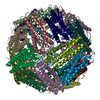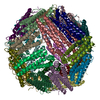+Search query
-Structure paper
| Title | Observation of the Protein-Inorganic Interface of Ferritin by Cryo-Electron Microscopy. |
|---|---|
| Journal, issue, pages | J Am Chem Soc, Vol. 147, Issue 4, Page 3333-3340, Year 2025 |
| Publish date | Jan 29, 2025 |
 Authors Authors | Sagnik Sen / Amar Thaker / Alison Haymaker / Dewight Williams / Po-Lin Chiu / Brent L Nannenga /  |
| PubMed Abstract | Visualizing the structure of the protein-inorganic interface is critically important for a more complete understanding of biomineralization. Unfortunately, there are limited approaches for the direct ...Visualizing the structure of the protein-inorganic interface is critically important for a more complete understanding of biomineralization. Unfortunately, there are limited approaches for the direct and detailed study of biomolecules that interact with inorganic materials. Here, we use single-particle cryo-electron microscopy (cryo-EM) to study the protein-nanoparticle (NP) interactions of human light chain ferritin and visualize the high-resolution details of the protein-inorganic interface. In this work, we determined the 2.85 Å structure of human light chain ferritin bound to its native iron oxide NP substrate. The resulting cryo-EM maps confirmed and enhanced previously proposed interactions of the protein with the material along the B-helix and revealed new interaction at the C-terminus of light chain ferritin. This work sheds new light on the mechanisms of ferritin biomineralization and further demonstrates the application of cryo-EM for the study of protein-inorganic systems. |
 External links External links |  J Am Chem Soc / J Am Chem Soc /  PubMed:39815632 PubMed:39815632 |
| Methods | EM (single particle) |
| Resolution | 2.1 - 3.3 Å |
| Structure data | EMDB-44778: C-terminus truncated (last two residues) mutant of Human light chain ferritin reacted with Ferrous salt(3 Fe2+ per ferritin subunit) . Reconstruction of particles with one nanoparticle. EMDB-44779: Human light chain ferritin reacted with iron (3 Fe2+ to ferritin monomer ratio). Reconstruction of particles with one nanoparticle. EMDB-44780: Human light chain ferritin reacted with iron (3 Fe2+ to ferritin monomer ratio). Reconstruction of particles with no nanoparticle. EMDB-44797, PDB-9bq5: |
| Source |
|
 Keywords Keywords | METAL BINDING PROTEIN / Iron oxide binding protein |
 Movie
Movie Controller
Controller Structure viewers
Structure viewers About Yorodumi Papers
About Yorodumi Papers











 homo sapiens (human)
homo sapiens (human)